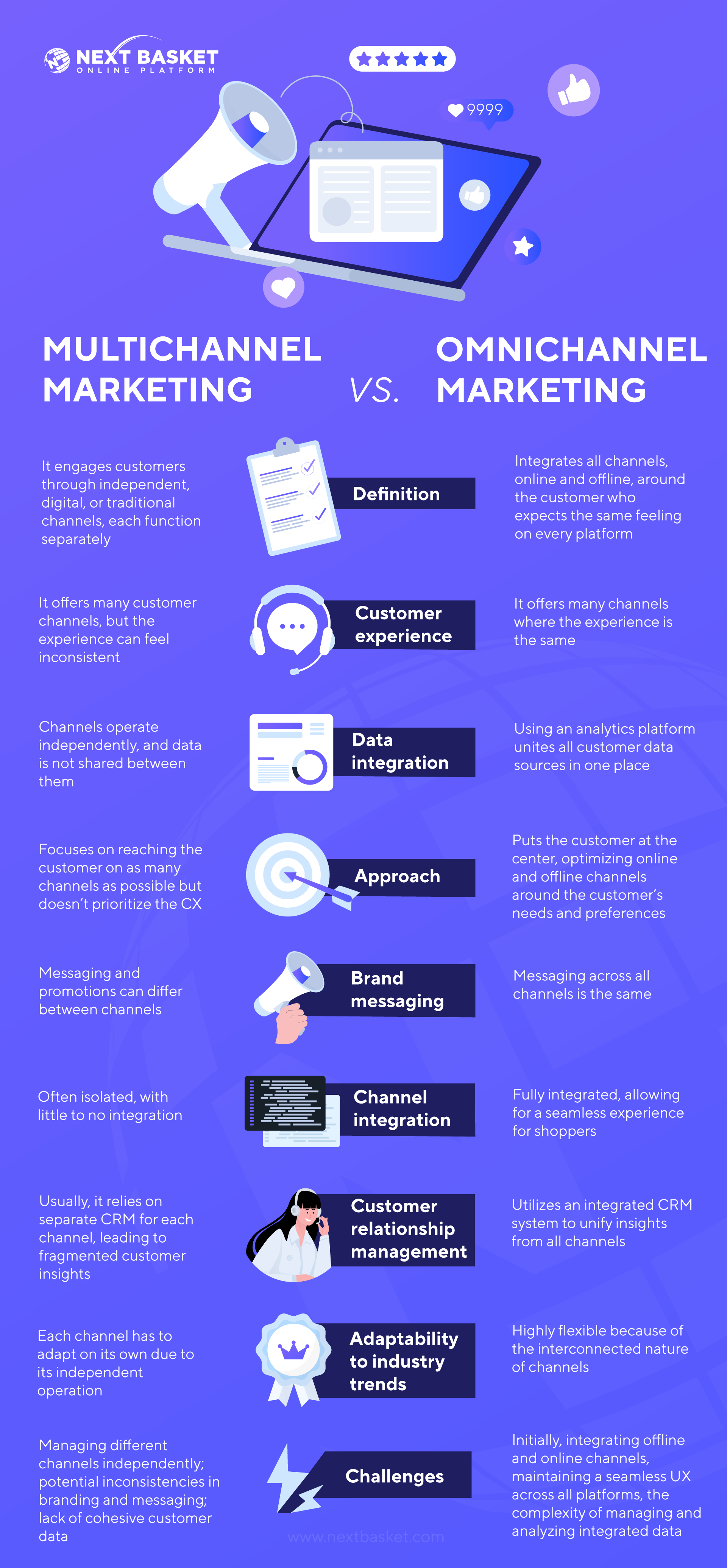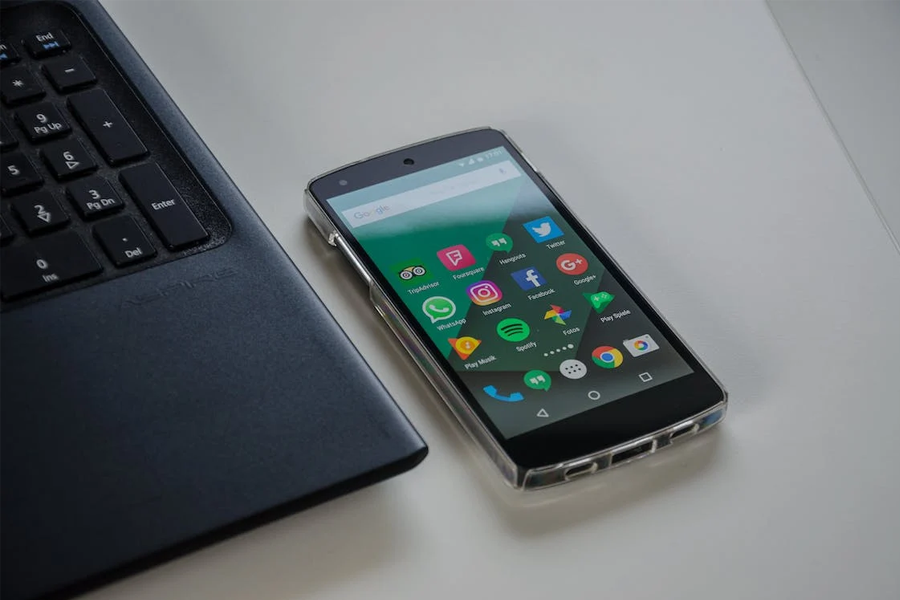Omnichannel marketing has become fast-rising as it improves customer experience and skyrockets conversion rates. An omnichannel approach involves unifying customer interaction across multiple channels.
For example, after searching for chocolate cake online, you click on a result on the first page, and later, when scrolling through Instagram, you see an offer related to the website’s offer – a great practice of omnichannel marketing.
An omnichannel marketing strategy allows you to create a personalized customer experience because each customer wants different things. Moreover, research has proven that omnichannel customers will buy 1.7 times more than those from a single channel. What is omnichannel marketing, and why is it important?
Keep reading!

Definition of Omnichannel Marketing
Breaking the word omnichannel into Omni channel helps us understand that omni means altogether, translating to altogether channels. Simply, it means all channels acting together. Omnichannel marketing is the process of developing an omnichannel strategy to create a unified experience for a customer to promote your business across all channels.
The main objectives of omnichannel marketing include the following:
- Deliver consistent messaging with your brand across multiple channels and at the right time at each customer journey stage.
- Improve customer service by providing a memorable customer experience for your customers.
Omnichannel marketing allows you to interact with your customers continuously, even after purchase. It’s more about tailoring content to your customers as they pass through the customer journey. These channels may include social media, SMS, email, live events, websites, and paid advertisements.

Benefits of Omnichannel Marketing
With omnichannel marketing, you say the right things at the right time. You are not giving repeat customer offers meant for yet-to-convert prospects. It allows for a frictionless customer experience. An omnichannel marketing strategy can provide your business with more tremendous benefits.
Let’s see them below:
- Improving customer experience and loyalty.
- Delighting and attracting the right customers.
- Gaining valuable customer insights.
- Engaging customers even after purchase to boost their loyalty.
- Boosting sales.
If a customer stumbles upon your ad on Instagram, clicks, and lands on your website, omnichannel marketing allows them to keep seeing offers related to what they want across the internet.
Omnichannel Vs. Multichannel Marketing

Omnichannel and multichannel marketing are two distinct approaches to engaging with and reaching customers across various platforms.
In this section, we outline the difference between them, so you can understand the two marketing channels in detail.
What is Multichannel Marketing?
On hearing about channel marketing, you may have thought, Aren’t they the same thing? Not to disappoint you, but they are two distinct terms. Multichannel marketing involves using more than one channel to promote your business, and unlike omnichannel marketing, It doesn’t include streamlined experience.
It just involves using TV, social media, print, email, display ads, billboards, and brick and mortar stores to sell to customers without unifying their experience. For example, you may see the Facebook ad of a brand telling you to buy with a 40% discount and check Instagram to see an ad urging customers to repeat purchases. This way, a single brand uses different channels but hasn’t integrated each medium.
How Does Multichannel Marketing Work?
Multichannel marketing works by identifying the target market and choosing the proper channels to target them: brick-and-mortar stores, content marketing, social media, email marketing, paid advertising, and more.
You need to develop marketing messages tailored for each channel and track each channel’s performance separately. Also, you should adjust each channel strategy as time goes on. Unlike omnichannel marketing, multichannel marketing aims to expand brand reach and maximize conversion per channel.
What Is Omnichannel Marketing?
Like multichannel marketing, omnichannel marketing involves promoting through multiple channels but allows channel integration to create a unified customer experience. Simply put, as customers move through your active channels, their experience is singular and unique to their needs.
Whatever they see on your site, brick-and-mortar store, and Facebook page aligns with their journey.
How Does Omnichannel Marketing Work?
Here is an overall picture of how omnichannel marketing works: Following a customer purchase from your walk in store, they received a text message to confirm their purchase. While browsing through Instagram, they saw a juicier offer telling them to buy another item for an 80% discount in a timeframe. This way, you get them to repeat the purchase effortlessly.
The overall difference between omnichannel and multichannel marketing lies in their objectives. Multichannel optimizes for marketing per channel, while omnichannel optimizes personalized customer experience along the customer journey. Both are significant and can impact your business positively.

Components of an Effective Omnichannel Marketing Strategy
There are several factors to consider before creating an omnichannel strategy. Without these components, your marketing strategy may not yield results.
Don’t leave any of them out for a seamless and cohesive marketing approach.
Integrated Marketing and Sales Channels
You have to selectively choose multiple channels your customers are active on to make them learn about your products subconsciously. By integrating these channels, you are not forcing your brand on them.
It’s a more seamless experience across Instagram and Twitter through SMS push notifications or emails. Your sales channels focus more on conversion. Online stores, brick and mortar stores, and mobile apps are great suggestions for sales channels.
Developed Operational Workflow
To succeed with omnichannel marketing, you need to be intentional and organized. You must carefully develop marketing strategies and handle customer relationship management (CRM) tools well.
A disorganized omnichannel marketing will lead to poor results, so it is essential to streamline your company’s operations.
Packaging
Customers are shopping to get their products. How about you personalize the packaging to their experience using thank you cards or stickers? Also, ensuring timely delivery adds to the entire omnichannel experience.
By integrating marketing and channel sales, you will cater to your audience’s presence across various platforms without overwhelming them. Personalized packaging and timely delivery also boost customer experience, making each interaction with your brand memorable.
Examples of Successful Omnichannel Marketing Campaigns
We’ve outlined some great examples of omnichannel marketing below. They have all adopted an integrated marketing approach and have exceeded customer expectations, which boosted customer loyalty and drove sales in innovative ways.
Let’s have a closer look at how they’ve implemented omnichannel marketing for success.
Nike
Nike has built a successful business with omnichannel marketing for years. It uses both offline and online means to unify the customer experience.
It uses an ever-growing platform of content, offers, and community interactions, like its SNKRS and Run Club apps, to facilitate in-person meetups. Nike also provides an app for individual workouts to create customer experiences that transcend shoe and apparel lines.

Best Buy
Best Buy has both a walk-in store and an online shop. It improved the in-store experience with its smart home technology solutions paired with free in-home advisory service.
It also has a mobile app that lets customers scan to shop. Customers can pick up from the store, smoothing the customer experience.
Sephora
Sephora capitalizes on omnichannel marketing to create a personalized experience for their customers. It uses customized push notifications, ensuring customers can book in-person consultations effortlessly. Its powerful in-store technology enables employees to find customer favorites and suggest products they might try next. They also offer consistent beauty tips with the brand experience and free makeovers.
With the Sephora app, customers can keep a wish list, track past purchases, and scan items while they are in the store. These unify customer experience and have helped the brand gain a 100% increase in mobile orders.
You can see how omnichannel marketing can help you to become a top player in your industry if you do it right since customers are the center of every business.
How to Create an Omnichannel Marketing Plan
It involves developing a cohesive strategy that integrates the selected marketing channels to provide customers with a unified experience.
Below is a step-by-step guide on how to create an effective omnichannel marketing plan:
- Understand Your Audience: Firstly, you should’ve researched and drawn out a buyer persona that details their preferences, behaviors, and expectations across different channels. Consider using analytics tools and customer feedback to understand how customers interact with your brand.
- Define Your Goals: Is your business at the point where it can afford omnichannel marketing? After answering that, Clearly outline your overall marketing objectives to understand if omnichannel marketing should be your next step because it requires intentional and concise efforts. Your omnichannel marketing goals may include customer engagement, brand awareness, sales, and retention.
- Choose Your Marketing and Sales Channels: Based on customers’ preferences, where should you integrate omnichannel marketing? From your research, do you need to build a mobile app? You can always start by experimenting and later go big.
- Integrate Data and Technology: Use a Customer Relationship Management (CRM) system to centralize customer’s data. This way, you ensure seamless data integration across all channels and gain a holistic view of customer interactions.
- Consistent Branding: You should maintain consistent branding elements such as logo, colors, and messaging across all channels. It ensures a unified brand voice and makes you memorable to customers.
- Personalization: Personalization is the soul of omnichannel Marketing, so it cannot be overemphasized. You need to tailor content, promotions, and recommendations based on individual preferences and behaviors.
- Smooth Cross-Channel Communication: It is essential to consider smooth communication between channels. For example, a customer should be able to start a transaction on one channel and complete it on another without hiccups.
- Implement Automation: Omnichannel marketing is impossible without ecommerce automation. You need technology to streamline the customer experience and ensure timely and relevant communications.
- Measure and Analyze: You have outlined your goals; now, you need to develop KPIs to align with your goals and measure them regularly.
- Optimize and Iterate: Optimize your strategy based on omnichannel results, data insights, and customer feedback.
Lastly, ensure that your team is trained to understand and implement the omnichannel strategy.
The above steps can help you to create an effective omnichannel marketing plan that enhances the customer experience and drives positive business outcomes. Always allow for flexibility and adaptability as market dynamics and consumer behaviors evolve.
Tools and Technologies to Support Omnichannel Marketing
To support omnichannel marketing effectively, you can leverage a variety of tools and technologies that help you integrate, automate, and optimize your marketing efforts.
Here are some of the key types of tools and technologies you should consider:
- Customer Relationship Management (CRM) Software: Centralized customer data from various channels, enabling personalized communication and insights into customer behaviors.
- Content Management Systems (CMS): Supports the creation, management, and optimization of content across different platforms.
- Marketing Automation Platforms: Automates marketing tasks and workflows, ensuring consistent messaging across channels.
Also, by using omnichannel commerce solutions, you can leverage many different channels that your target audience uses.
Common Challenges and How to Overcome Them
As every other marketing strategy, omnichannel marketing has its challenges that you need to be aware of.
Let’s review them below:
- Complex Data Integration: Effective omnichannel marketing requires extensive data integration from different media, including mobile apps, websites, email campaigns, social media, and in-store interactions. Integrating the data across all channels could be daunting as they have separate data formats, structures, and platforms.
- Consistency Across Channels: It won’t be easy to be consistent in messaging, personalization, and branding across multiple channels. Inconsistency can lead to a lack of trust and hesitation from potential customers.
- Privacy and Data Security: Some customers will likely feel that their privacy is breached if they keep seeing ads related to a product they only searched for once or aren’t interested in. So, you must keep that in mind and automate omnichannel marketing for customers who have shown interest more than once. If you are not cautious enough, it could result in a data breach lawsuit.
The main goal of omnichannel marketing is to personalize the customer experience, but it can be challenging to create a seamless, personalized experience even after segmenting customers.
To resolve this, segment customers based on data and behavior into smaller, more manageable groups. Develop a message flow for each segment; for example, if a prospect were to switch between Facebook and Instagram, this is the message they would see.
Measuring Success in Omnichannel Marketing Tools and KPIs
You can’t tell if you’ve had successful omnichannel marketing without measuring key metrics.
Below, we will provide you with the most important metrics to follow:
- Average Order Value (AOV): This is the average amount the customer spends. Calculate it by dividing the total worth of sales per customer. A high AOV indicates that customers are making larger purchases, while a lower value AOV shows that customers may have increased but are buying less expensive items. Either way, it tells you what products to focus on in omnichannel marketing, which should help you achieve your aim of selling out the products.
- Buy Online, Pickup in Store (BOPIS): As a business owner, you will see cases where customers order online but prefer to pick up. Omnichannel marketing ensures that when customers come to pick up, their experience is better. Also, you have to ensure stock data remains updated. It won’t be messy for customers to order online and come to pick it up, only for it to be sold out.
- Customer Acquisition Cost (CAC): The CAC should significantly drop with omnichannel marketing. Consider each channel. Compare the efforts and resources spent on each channel. For example, you could spend more time and money selling on Facebook than on Instagram, but your primary traffic source could be Instagram. This means you should focus more on Instagram.
- Customer Lifecycle Value (CLV): The Customer Lifecycle Value (CLV) tells us how much a buyer will spend in your shop till they stop buying from you. It’s calculated with the formula: CLV = Average order value x Number of monthly transactions x Retention period.
- Net Promoter Score (NPS): The Net Promoter Score (NPS) measures the possibility of a customer recommending your brand or store to another person. A high NPS indicates that your customer service is top-notch.
It’s important to remember all of these when tracking your omnichannel marketing performance, especially the CAC and CLV. They tell you if it’s worth acquiring customers through omnichannel marketing.
Conclusion
We explained what omnichannel marketing is and discussed some of its benefits. From the differences between omnichannel and multichannel marketing to an explanation of omnichannel marketing components, the future of marketing lies in the ability to create a unified customer experience.
Examples of successful campaigns by giants like Nike, Best Buy, and Sephora show that omnichannel marketing is dynamic and can drive sales and foster brand growth. Furthermore, we discussed creating an omnichannel marketing plan and the possible challenges you can face with it. With the right tools, technologies, and strategies, businesses can overcome the hurdles to deliver a seamless marketing experience.
Frequently asked questions
What are the three aspects of omnichannel marketing?
Omnichannel marketing consists of three main aspects: branding, messaging, and touchpoints as consumers move along the sales funnel.
Why is omnichannel one of the best marketing strategies?
Omnichannel marketing is the one of the best strategies because it is customer-centric, boosts customer experience, and provides multiple channels for customer contact, i.e., the web, mobile, or stores.
What is the main disadvantage of omnichannel?
The main disadvantage of omnichannel is that it requires time, extra money, effort, and resource investment to make it work. And at the end of the day, it may all go to waste if not done well, making tricky marketing options.